1993 CHEVROLET CORVETTE window
[x] Cancel search: windowPage 138 of 370
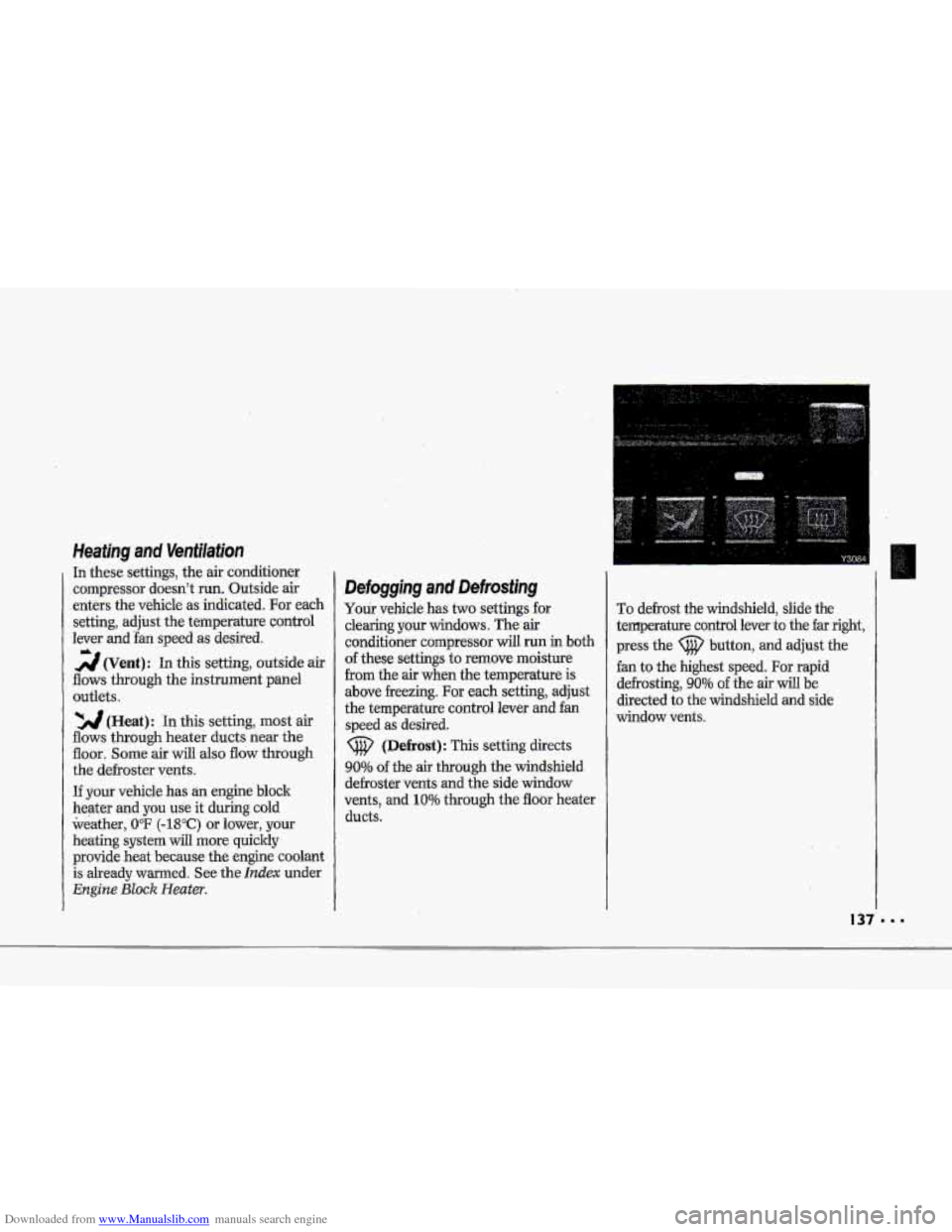
Downloaded from www.Manualslib.com manuals search engine i
! I
r I
p"
p"
p" 1 !
F
Heating and VentMion
In these settings, the air conditioner
compressor doesn't
run. Outside air
enters the vehicle as indicated. For each
setting, adjust the temperature control
lever and
-fan speed as desired.
flows through the instrument panel
outlets.
*A (Hwt): .In this setting, most air
flows through heater ducts near the
floor. Some
air will also flow through
the defroster vents.
If your vehicle has an engine block
heater and you use it during cold
weather,
0°F (-18°C) or lower, your
heating system will more quickly
provide ,heat
because the engine coolant
is already warmed. See the Index under
Engine Block Heater.
4
(Vent): In this setting, outside air
Defogging and Defrosting
YoUr vehicle has two settings for
clearing your windows. The-air
conditioner
compressor will run in both
of these settings to remove moisture
from the air when the temperature is
above freezing. For each setting, adjust
the temperature control
lever and fan
speed as desired.
(@ (Defrost): This setting directs
90% of the air through the windshield
defroster vents
and the side window
vents, and 10% though the floor heater
ducts.
To defrost the windshield, slide the
temperature control lever
to the far right,
press the (@ button, and adjust the
fan to the highest speed.
For rapid
defrosting,
90% of the air will be
directed to the windshield and side
window vents.
Page 139 of 370
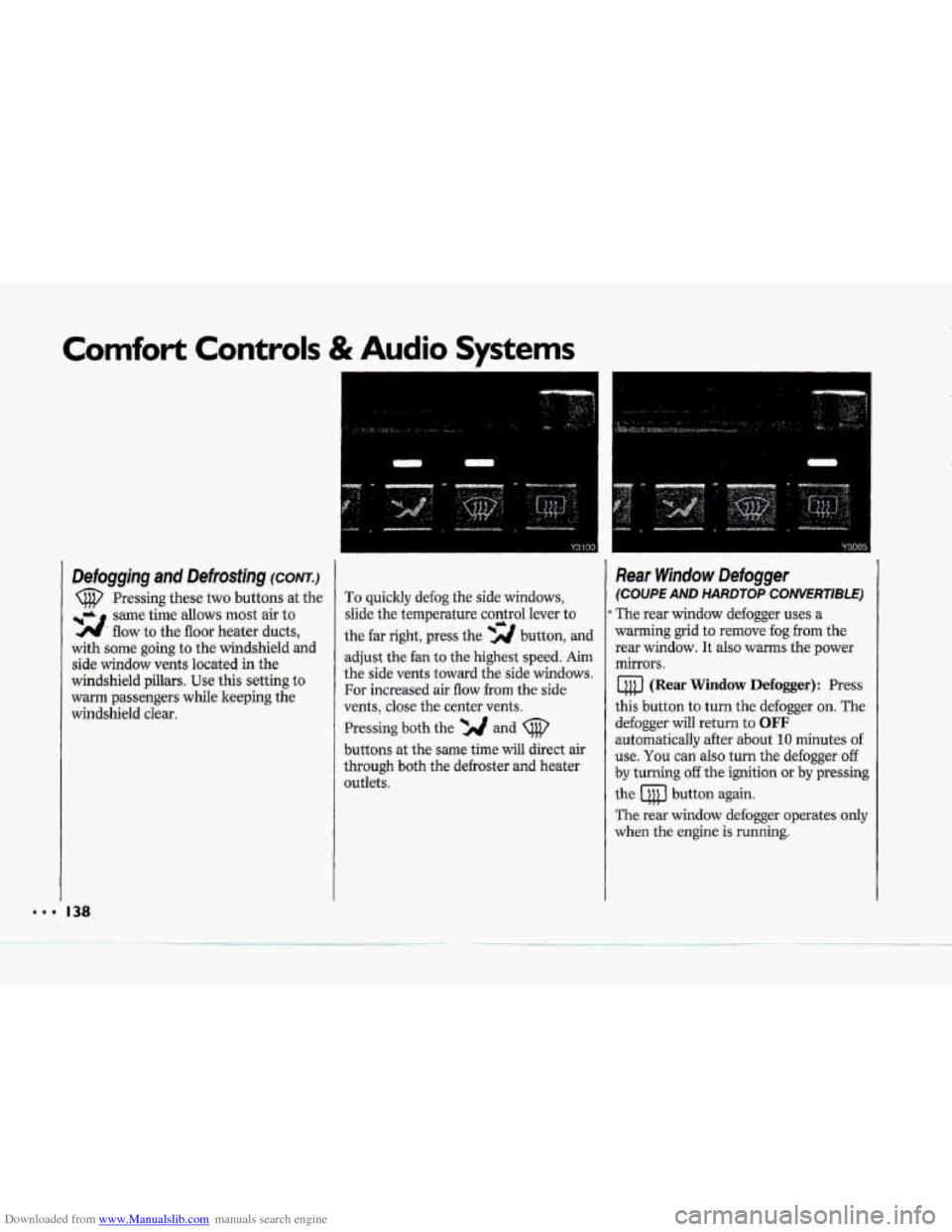
Downloaded from www.Manualslib.com manuals search engine Comfort Controls & Audio Systems
Defogging and Defrosting (cow
Pressing these two buttons at the
same time
allows most air to
flow to the floor heater ducts, -2.
with some going to the windshield and
side window vents located in the
windshield pillars. Use this setting
to
warm passengers while keeping the
windshield clear.
I38
To quickly defog the side windows,
slide the temperature control lever
to
the far right, press the -2 button, and
adjust the fan to the highest speed. Aim
the side vents toward the
side windows.
For increased air flow from the side
vents, close the center
vents.
Pressing both the *A and
buttons at the same time will direct air
through both the defroster and heater
outlets.
Rear Window Defogger
(COUPE AND HARDTOP CONVERTIBLE)
The rear window defogger uses a
warming grid to remove fog from the
rear window.
It also warms the power
mirrors.
(Rear Window Defogger): Press
this button to turn the defogger on. The
defogger
will return to OFF
automatically after about 10 minutes of
use. You can
also turn the defogger off
by turning off the ignition or by pressing
the button again.
The rear window defogger operates only
when the engine is running.
c
Page 140 of 370
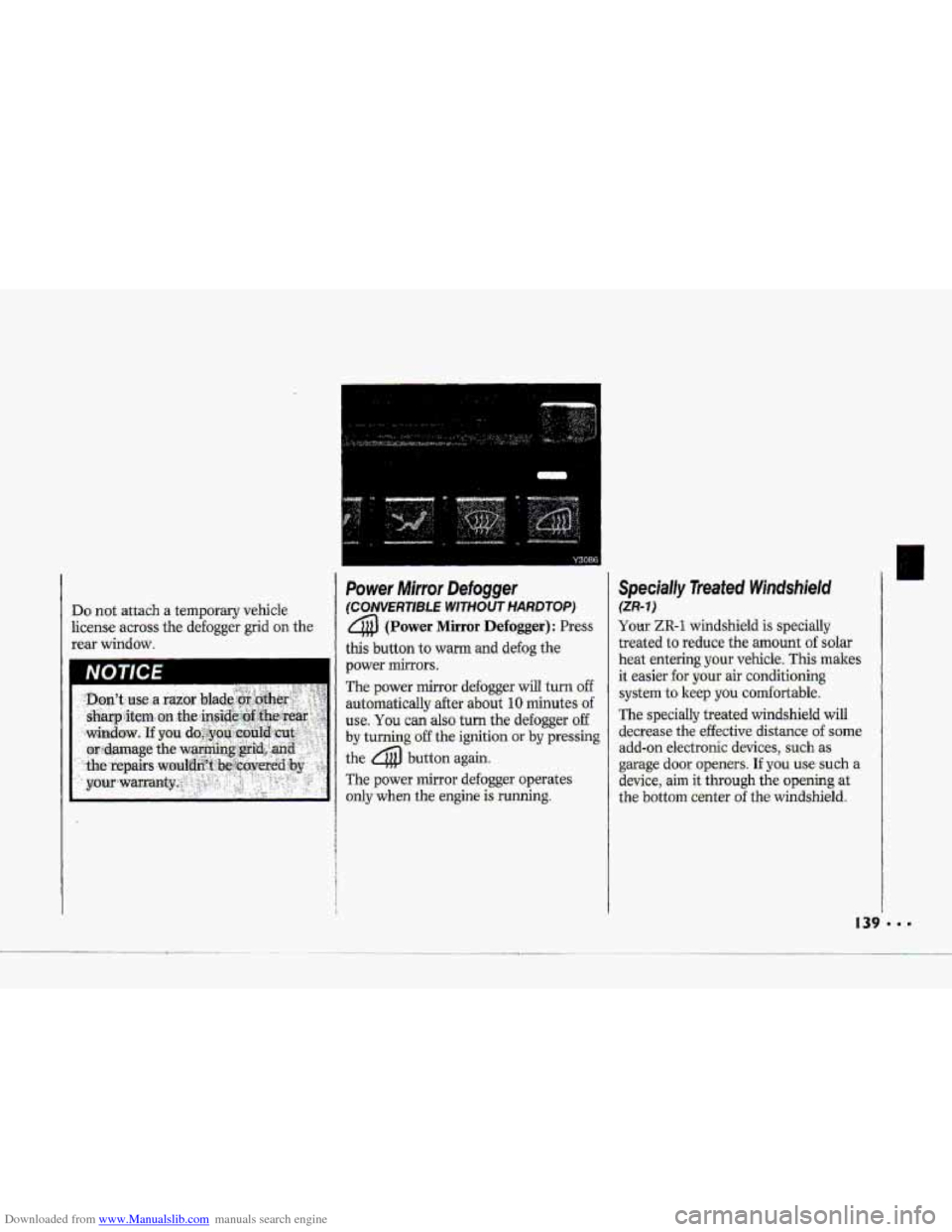
Downloaded from www.Manualslib.com manuals search engine a
Do not attach a temporary vehicle
ficense across the defogger
grid .on the
rear window.
Power Mirror Defogger
(COW€RT/BLE WITHOUT HARDTOP)
4 (Power ,Mirror Defogger): Press
this buttqn to warm and defog the
power mirrors.
The power
mirror defugger will turn off
automatically after about 10 minutes .of
usei You can also turn the defogger off
by turning off the-ignition or by pressing
the
4 but'ton again.
The power mirror defogger operates
only-when the engine is running.
SpecMy Tieated Windshield
(ZR- 7)
Yolar ZR-1 windshield is specially
treated
to reduce the amount of solar
heat entering your vehicle. This makes
it easier for your air conilitioning
system to keep you comfortable.
The specially treated windshield will
decrease the effective
distance of some
add-on electronic devices, such as
garage
door openers. If you use such a
device, aim it through the opening at
the bottom
center of the windshield.
Page 144 of 370
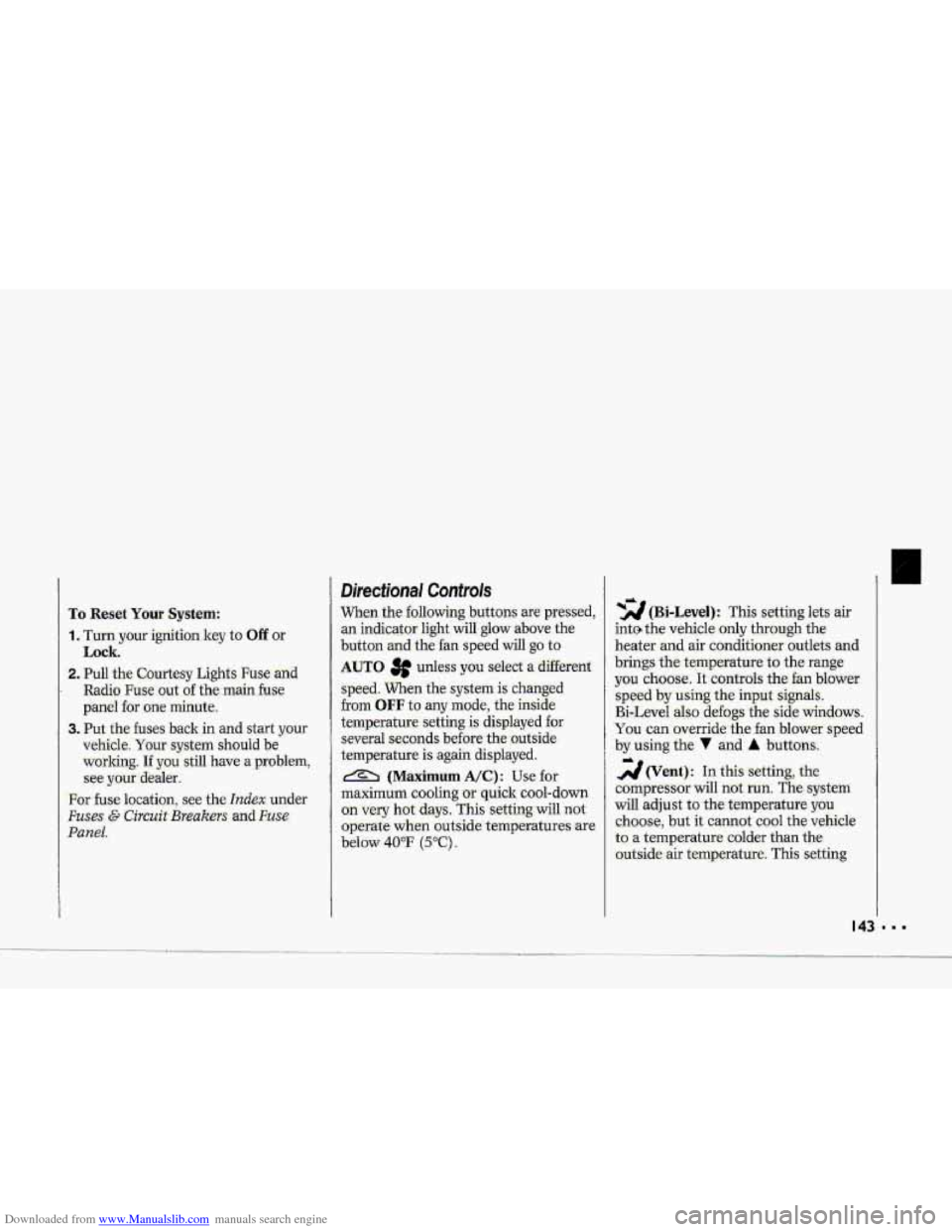
Downloaded from www.Manualslib.com manuals search engine h
P
To Reset Your System:
1. Turn your ignition.lrey to Off or
Lock.
2. Pull the Courtesy Lights Fuse and
Radio Fuse .out of the- main fuse
panel for
one minute.
3. Put-the fuses back in and start your
vehicle. Your system shuuld be
working.
If you still have a problem,
see your deder,
.For
fuse location, see the Index under
Fuses E. CircuitBreakers and Fuse
.Panel.
Directional Controls
When the €allowing buttons are pressed,
an indicator light.
will glow above .the
button and the fan speed will go to
AUTO 3f unless you select a dBerent
speed. When the system is'changed
€rum
OFF tu any mode, the inside
temperature setting is displayed for
several seconds before the .outside
temperature is again displayed.
& (Maximum A/C): Use for
maximum cooling
or quick cool-down
on very hot days..
This setting will not
operate when outside temperatures are
below
40°F (5°C) I
-2 (Bi-Level): This setting lets air
inte the vehicle only through the
.heater and air conditioner outlets and
brings.the temperature
to the range
you choose. It controls the fan blower
speed by using t-he input signals.
Bi-Level al.so
defogs the side windows,
You can. override the,fan blower speed
by using
the V and A buttons.
a(Vent): In this setting, the
compressor
will not. mn. The-system
will adju-st
to the temperature you
choose, but it cannot cool the vehicle
to a temperature colder than the
outside air temperature, This setting
Page 145 of 370
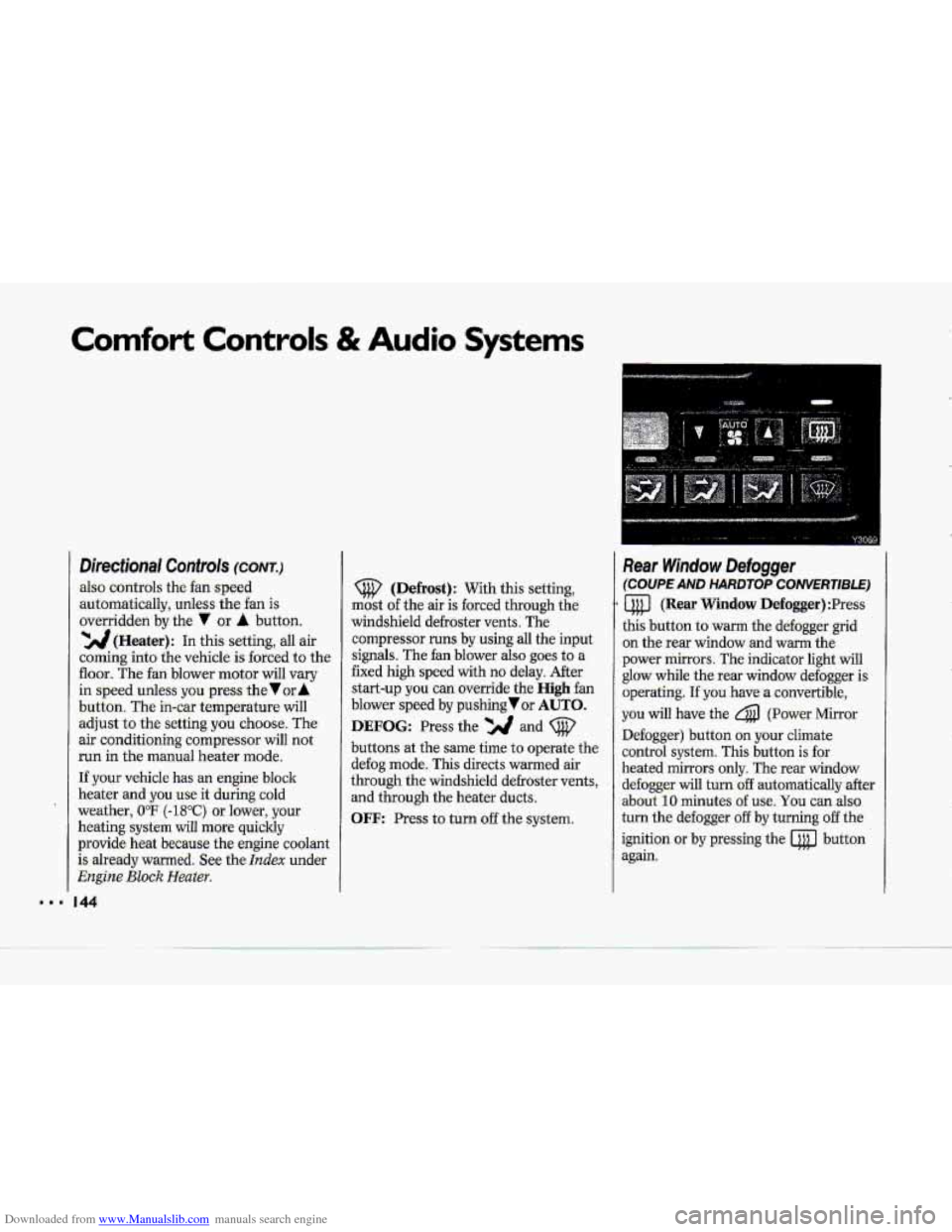
Downloaded from www.Manualslib.com manuals search engine ...
Comfort Controls & Audio Systems
Directional Controls (CONT.)
also controls the fan speed
-automaticallyy, unless the fan is
overridden
by the 7 or A button.
'YJJ(Heater): In this setting, all air
coming into the vehicle. is forced to the
floor. The fan blower motor will vary
in speed unless yowpress the Vur A
button. The in-car temperature will
adjust to the setting you choose. The
air conditioning compressor will not.
run in the manual heater mode.
If .your vehicle has an
engine block
heater
and you.use .it during cold
weather,
UoF (-18°C) or lower, your
heating system will .more quickly
provide heat became the engine coolant
is already warmed. See the
Index under
Engine Bluck Heater.
44
(Defrost): With this setting,
mast
of the air is forced. through the
windshield defroster vents. The
cornpressor
runs by using all the input
signals. The fan blower also .goes to a
fixed
high speed with no delay. After
start-up you can override the High fan
blower speed by pushing or AUTO.
DEFOG: Press the and (@'
buttons at the same time to operate the
defog mode. This directs warmed air
through the windshield defroster
vents,
and through the heater ducts.
OFF: Press to turn off the system.
Rear Window Defogger
(COUPE AND HARDTOP CONVERTlBLE)
a (Rear Window Defogger) :Press
this button to warm the defogger grid
on the rear window and
warm the
power mirrors. The indicator light will
glow while the rear window defogger is
operating.
If you have a convertible,
you. will have the 4 (Power Mirror
Defogger) button .on your climate
control system. This button
is for
heated mirrors only. The -rear window
defogger
will turn:off automatically after.
about
10 minutes. of use, You can also-
turn the defogger
off by turning off the
ignition
or by pressing the @ button
again.
Page 146 of 370
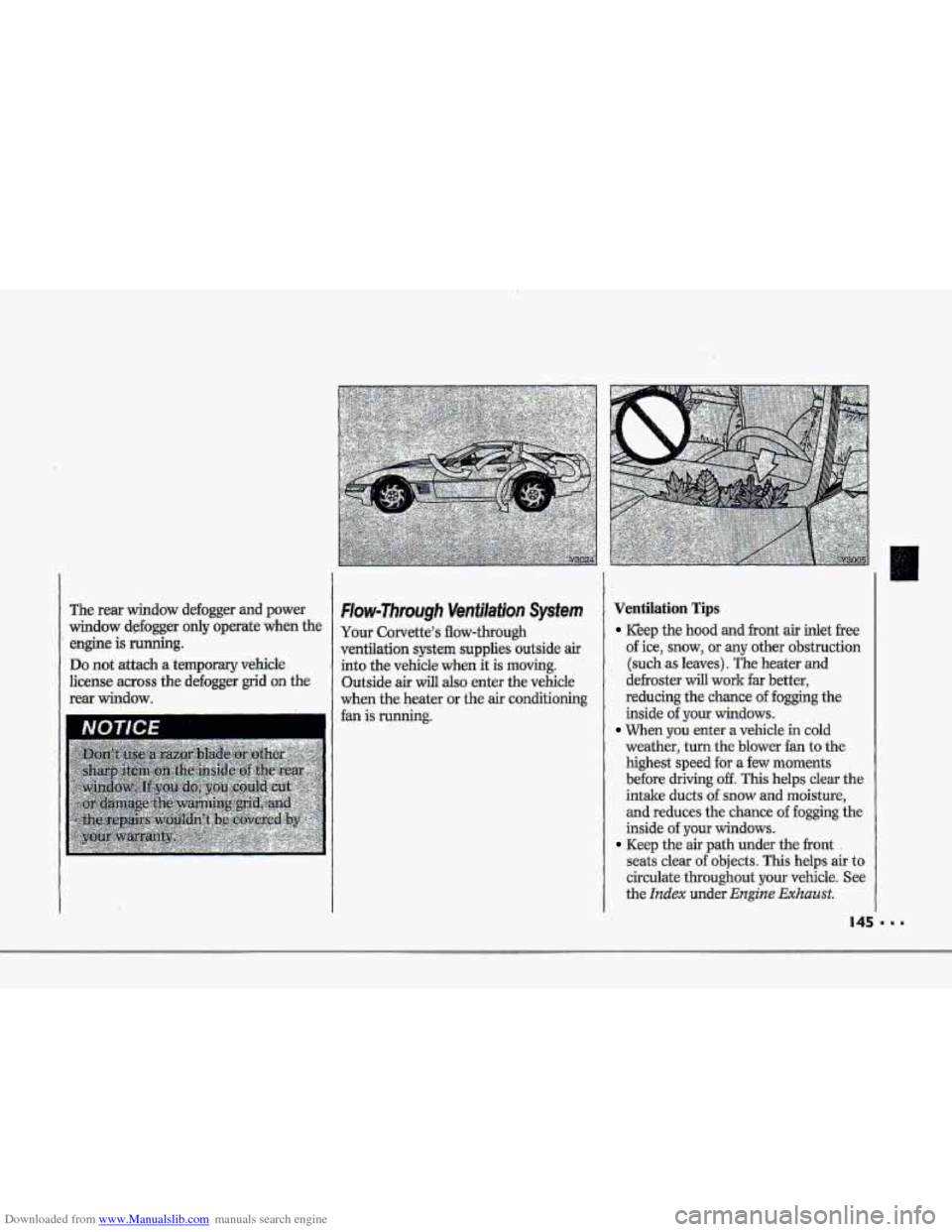
Downloaded from www.Manualslib.com manuals search engine r
f" i
r" j
r I
F
The rear window defogger and power
window defogger .ody aperate when the
Do pot attach a temparary vehicke
license across the defogger grid on the,
rear window.
' engine is ru~g.
Flow-Throuflh Ventilation System
Your corvette's flow-through
ventilation system supplies outside air
into
the vehicle when it is moving.
Outside air will also enter the vehicle
when the heater or the air conditioning
fan is mag.
Ventilation Tips
Kkp the hood and €rant air inlet free
-of ice, snow, or any other obstruction
(such as leaves). The heater and.
defroster dl work far better,
reducing the chance of fogging the
inside of you windows.
When you enter a vehicle in cold
weather, turn the blower fan to the
highest speed f6r.a few moments
before driving off. This helps clear the
intake ducts of 'snow and moisture,
.and reduces the chance of fogging the
inside a€ your windows.
seats clear of objects. This- helps air to
circulate t.hroughout your vehicle. See
the Ind& under Engim? Exhaust.
Keep the air path u,nder the frwt .
Page 156 of 370
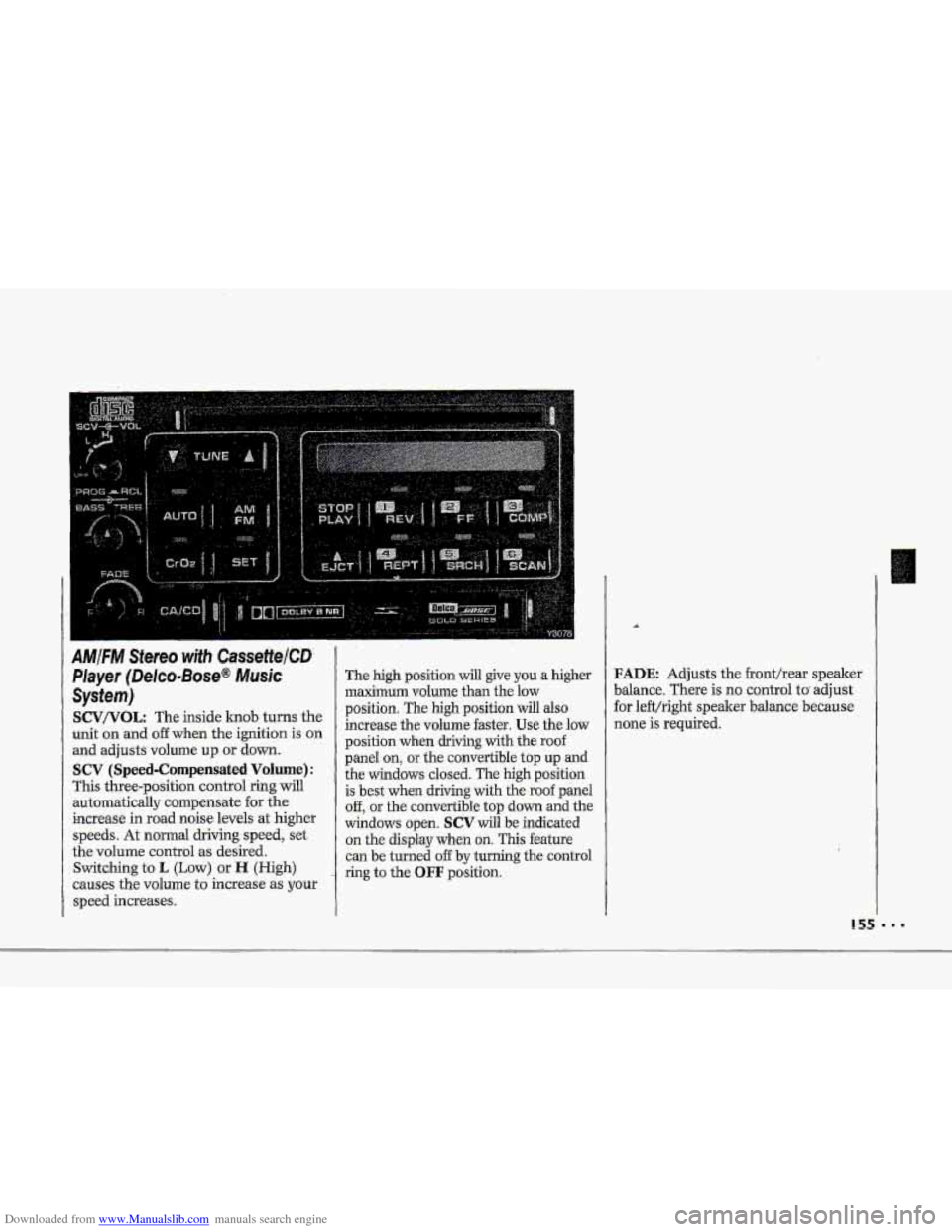
Downloaded from www.Manualslib.com manuals search engine i
F
I
p4
I
AMIFM Stereo with CassettelCD
Player (Delco-Bose@ Musk
System)
SCV/VOL: The inside lcnob turns the
unit on and
off when the ignition is on
and adjusts volume up or down.
SCV (Speed-Compensated Volume):
This three-position control ring will
automatically compensate for the
increase in road noise levels
at higher
speeds. At normal driving speed, set
the volume control
as desired.
Switching to
L (Low) or H (High)
causes the volume
to increase as your
speed increases.
The high position will give you a higher
maximum volume than the low
position. The
high position will also
increase the volume faster.
Use the low
position when driving with the roof
panel
on, or the convertible top up and
the windows closed. The high position
is best when driving with the roof panel
off, or the convertible top down and the
windows open.
SCV will be indicated
on the display when on. This feature
can be turned
off by turning the control
ring to the
OFF position.
FADE Adjusts the fronthear speaker
balance. There is
no control to adjust
for left/right speaker balance because
none is required.
... .... ... .. ...
.... ... ... .... . :.. .. .... .. ..
Page 168 of 370
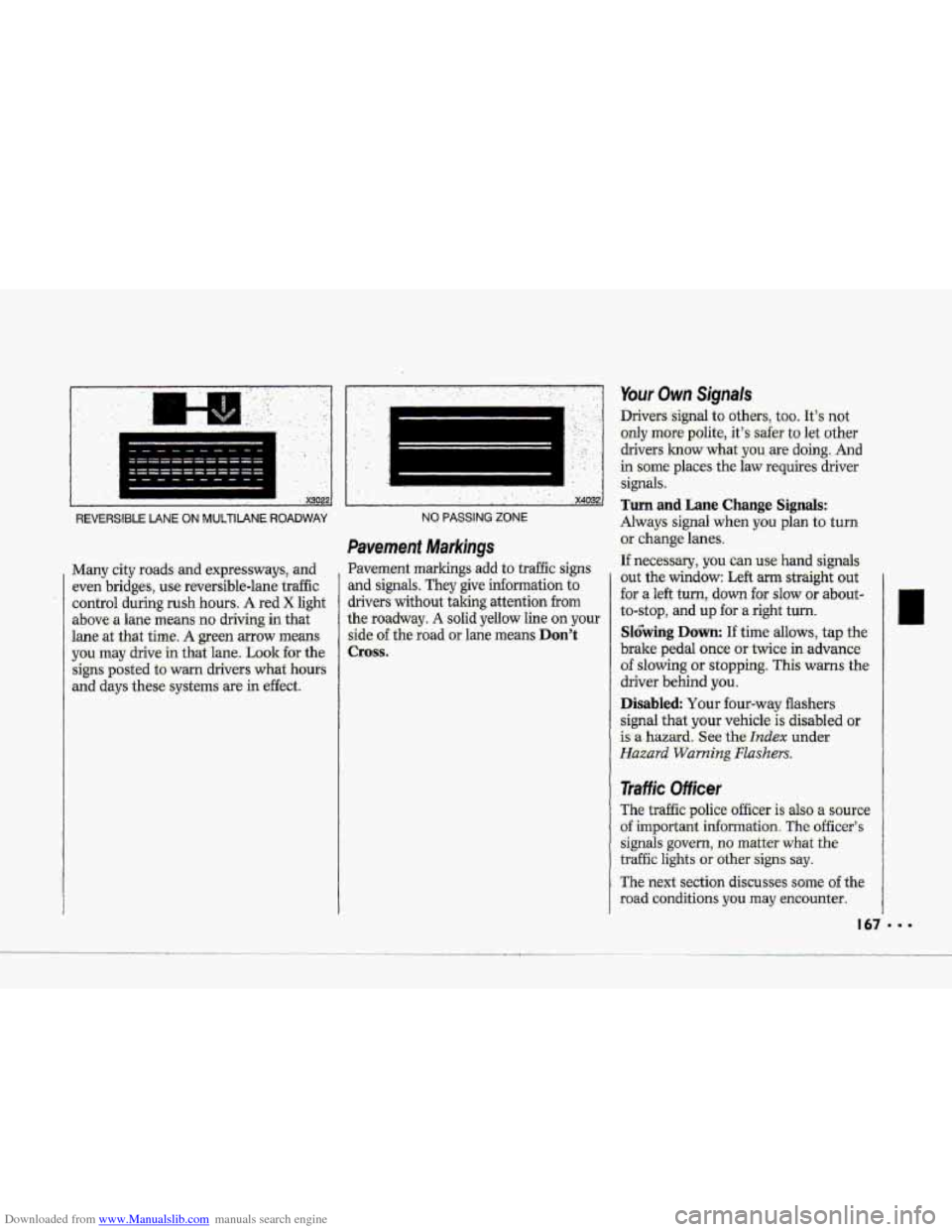
Downloaded from www.Manualslib.com manuals search engine c
R
II
I
1 .---
I I
1
,, -' , . x3022
REVERSIBLE LANE ON MUlTIIANE ROADWAY
Many city roads: and expressways, and
even bridges, use reuersible-lane traffic
control during
rush hours. A red X light
above- a lane means no driving in that
lane
at .that time. A green mow means
you may drive in that lane. Look €or the
signs posted to warn drivers
what hours
and days these = ,-.. systems are in effect.
.. ........... ........................ ... ,. ., ,. . ... . ' .' '. , ..
! ' x4032
NO PASSING ZONE
Pavement Markings
Pavement markings add to traffic signs
and signals. They give information to
drivers without iaking attention
from
the roadway. A solid yellow line on your
side of the road or lane means Don't
Cross.
Your Own Signals
Drivers -signal to other.s, too. It's not
only more polite.,. it's safer to let other
drivers
1mow what-you are doing-. And
in some' places the law requires driver
signals:
Turn and Lane Change Signals:
Always signal when you plan to turn
or .change lanes.
If neces-ssary, you can use hand signals
out the window: Left arm straight out
'for a left turn, down for slow :or about-
to-stop, and up for .a right turn.
Sl6bing Down: If time allows, tap the
brake pedal once or twice in advance.
of slowing or stopping. This warns the
driver behind
you.
Disabled Your four-wtiy flashers
signal
that. your vehicle is disabled or
is a hazard. See the hdex under
Hazard Warning Flashers.
Traffic Officer
The traffic police officer is also a source
of important information The officer's
signals govern, no matter what the
traffic lights or othersigns say.
The next section discusses some of the
road conditions you may encounter.